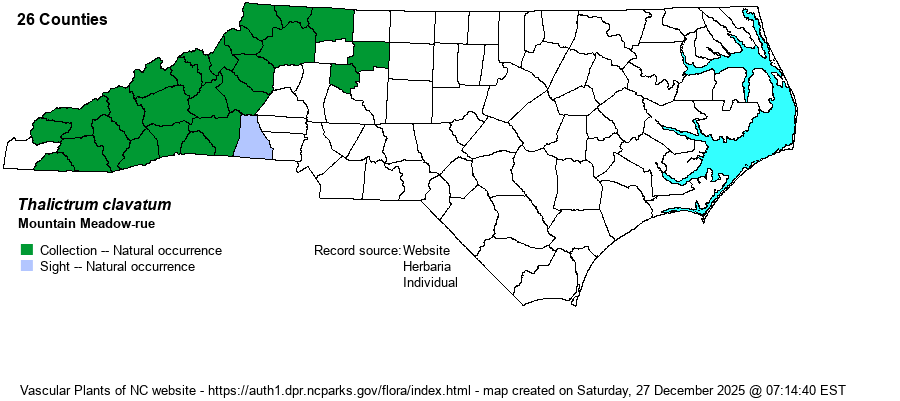| Author | de Candolle | |
| Distribution | Throughout the Mountains, and also occurs sparingly into the western Piedmont -- even into moderately low elevations such as in Forsyth and Davie counties.
This species is a Central and Southern Appalachian endemic, ranging from WV and KY south to northern GA. | |
| Abundance | Frequent to common over the entire Mountains; rare to uncommon in the Piedmont foothills, and very rare east to Forsyth and Davie counties. | |
| Habitat | This is a species of rich forests, though mainly close to cold water. It favors wooded seepages and streamsides, spray cliffs, and other similar places, but it certainly can be found in Rich Cove Forests. | |
| Phenology | Blooms from May to July, and fruits shortly after flowering. It blooms after the main push of spring wildflowers of cove forests (late March into early May). | |
| Identification | This is a rather slender herb, growing to about 1.5 feet tall. It has bi-ternately divided basal leaves -- i.e., about 9 leaflets per leaf, with each leaflet about 1 inch long and wide, in the shape of a rounded glove with a middle lobe and two small side lobes. The flowering stem may have a few leaves, and it is always branched such that there is a loose panicle of white flowers. These flowers have caducous sepals (dropping early) and no petals; the white color comes from the many filaments and stigmas, which produce a "spidery" flower about 1/2-inch across. In this species, the filaments are spreading, in all directions, and thus the flowers do not appear to be drooping, unlike with T. dioicum, another fairly numerous and slender montane species. There are a handful of other species with similar glove-like leaves/leaflets, such as T. thalictroides, though that is a rather tiny species that does not have a large and spreading inflorescence. This is an often encountered cool/shaded forest species, especially when you are walking montane trails near creeks and seepages. | |
| Taxonomic Comments | None
| |
| Other Common Name(s) | Lady-rue | |
| State Rank | S4 | |
| Global Rank | G4 | |
| State Status | | |
| US Status | | |
| USACE-agcp | FACW link |
| USACE-emp | FACW link |

